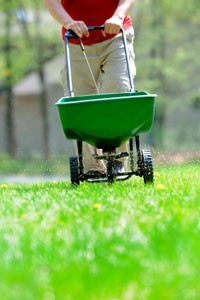
When it comes to lawn and garden problems, prevention is the best cure. Fall affords gardeners a great opportunity to set the tone for next year's growing season by way of soil preparation and cleanup. By putting in just a little bit of extra effort this fall, you spare yourself a whole lot less work and worry next spring.
Fall is the best time to clean up dead and decaying plant debris, and it's also a good time cut back spent foliage. Decomposing plant debris can provide a safe haven for overwintering insect pests and disease and removing it reduces the likelihood of having to deal with problems next year. Having a neat and tidy garden going into winter also means less time spent on cleanup in the spring, and makes it easier for tender shoots to push their way through the soil. In the coldest zones it's often better to leave spent foliage until spring. It offers plants extra winter protection by attracting and trapping insulating snow.
Weeds really go to town releasing their seeds in the fall. If you can, pull them up, clip them off at ground level, or collect the seeds by hand (or with a cordless handvac) before they have a chance to scatter. The same is true for any desirable self-seeders that have run a bit wild this season. Now is the time to regain control. Whatever you do, don't toss the seeds on top of the compost pile.
Fall is a great time to test your garden's soil, because once you get the results, you will still have plenty of time to add amendments before the really cold weather settles in. Once you've added you amendments, top off all of your vegetable and flower beds with 3 to 4 inches of compost. There's no need to work it in to the soil. Winter rain and snow will leach the organic nutrients into the soil, giving your plants a great head start next season.
Unlike other garden plants, it's beneficial to fertilize your lawn in the fall. Fertilizing it in the fall stimulates root growth to better survive winter, and shores up food stores for new growth next spring. Use an organic fertilizer labeled "fall" or "winterizing." This is also a great time to add lime if indicated by a soil test. Reduce your cutting height slightly for the last few cuts of the season.
One of the most common mistakes gardeners make is not irrigating properly in the fall. Frozen soil limits moisture availability, which can create a drought situation that damages (or even kills) plants during the winter. Give perennials and trees a good weekly soaking in the final weeks leading up to freezing weather. In colder zones where the ground freezes several inches deep, top plants with a heavy layer of organic mulch (4 to 8 inches deep depending on average snow cover) for some added protection. This will help prevent frost heaving and conserve moisture.

About The Author: Ellen Brown is an environmental writer and photographer and the owner of Sustainable Media, an environmental media company that specializes in helping businesses and organizations promote eco-friendly products and services. Contact her on the web at http://www.sustainable-media.com
Add your voice! Click below to comment. ThriftyFun is powered by your wisdom!